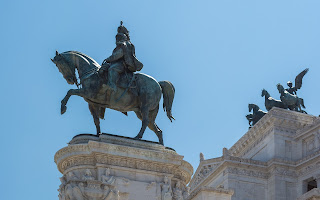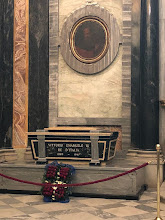Assassination attempts overshadow the reign of unpopular monarch
 |
| A portrait photograph, of unknown origin, of a young Umberto I |
As king, Umberto I led Italy into the Triple Alliance with Austria-Hungary and Germany, and his support for nationalistic and imperialist policies during his reign led to disaster for his country and helped to create the atmosphere in which he was eventually assassinated.
The son of King Victor Emmanuel II and Archduchess Adelaide of Austria, Umberto was brought up with no love or affection from his parents, but was instead taught to be obedient and loyal.
His father, whose 24th birthday fell on the day Umberto was born, gave him no training in politics or government and entrusted Umberto’s education to some of his statesmen.
Umberto went into the Royal Sardinian Army as a captain and took part in the Italian Wars of Independence. He was present at the Battle of Solferino when he was still only 14. Seven years later, in the Third Italian War of Independence, he commanded a division.
At the age of 24, Umberto married his first cousin, Margherita Teresa Giovanna, Princess of Savoy. They had only one son, Victor Emmanuel, Prince of Naples.
After the death of his father in 1878, when Umberto became king, he styled himself as Umberto I of Italy, rather than Umberto IV of Savoy, ignoring his three ancestral namesakes. This was even though his father, who had been the first king of Italy, had called himself Victor Emmanuel II, acknowledging his ancestor, Victor Emmanuel 1, King of Sardinia.
 |
| Umberto I and Queen Margherita on a visit to Venice in 1895 |
The anarchist, Giovanni Passannante, was initially condemned to death, but his sentence was later reduced to life imprisonment because the monarch was not killed.
However, this sentence was served by Passannante in a cell less than one and a half metres high, without any sanitation, while being weighed down with heavy chains. Passannante was to die 30 years later in a psychiatric institution.
Umberto’s admiration for German military aggression and keenness on Italian colonial expansion into Africa outraged some Italians and, after a government crackdown on civil liberties, protesters again took to the streets. This led to an unemployed man trying, but failing, to stab Umberto when he was seen out in the street in Rome in 1897.
Italians became even more outraged after Umberto I sent a telegram to congratulate General Bava Beccaris for using artillery against rioters protesting about the cost of bread in Milan in 1897. There were claims afterwards that 400 people had been killed and 2000 people had been wounded because of the heavy-handed tactics of the general.
Finally, in July 1900, anarchist Gaetano Bresci shot Umberto I four times while he was out and about in Monza and killed him. Afterwards Bresci said he had wanted to avenge the people who had been killed by the army while protesting two years earlier in Milan.
Umberto's body was taken to Rome and buried in the Pantheon, by the side of his father. They were the last Savoys to be laid to rest at the Pantheon. A monumental chapel was built in Monza close to the place where the assassination occurred.
 |
| The Pizza Margherita, with tomato, mozzarella and basil, was supposedly created in honour of Queen Margherita |
Unlike her husband, Umberto I’s queen, Margherita of Savoy, to whom he had been married in Turin in 1868, was immensely popular. In another contrast with Umberto, she was a highly educated woman who was equally at home in the company of ordinary people as she was with aristocrats or intellectuals. Her salon became one of the most exclusive and famous in contemporary Europe yet during her many tours of Italy in her official role she made a point of wearing local folk costumes and showing enthusiasm for local customs, traditions and culture. She was particularly loved in Naples, where she visited schools and hospitals and organised collections of toys and clothes for the children of poor families. She was seen to hold the hands of cholera victims without wearing gloves. Although the story is disputed, it is said that the Pizza Margherita, a staple of most pizza restaurants across the world, was originally created in her honour by Neapolitan pizza maker, Raffaele Esposito, with its tomatoes, basil and mozzarella representing the colours of the Italian flag. Esposito and his wife, Giovanna Brandi, were the original proprietors of the Naples institution, Pizzeria Brandi.
 |
| The Cappella Espiatoria was built close to the spot Umberto was killed |
The Cappella Espiatoria in Monza is a monumental chapel built in an act of atonement or expiation for the assassination of Umberto I by Gaetano Bresci. It was erected on Via Matteo da Campione, close to the entrance to the Royal Villa of Monza on Viale Regina Margherita, where Umberto was killed. The murdered monarch’s son, Vittorio Emanuele III, commissioned the architect Giuseppe Sacconi, and the work was completed by his pupil Guido Cirilli in 1910. Obelisk-like crosses emerge from a stone chapel, and are surmounted by bronze crown and royal symbols of the House of Savoy. The city of Monza - famous for its Grand Prix motor racing circuit - is also home to the Iron Crown of Lombardy - the Corona Ferrea - a circlet of gold with a central iron band, which according to legend, was beaten out of a nail from Christ’s true cross and was found by Saint Helena in the Holy Land. The crown is believed to have been given to the city of Monza in the sixth century and is kept in a chapel in the 13th century Basilica of San Giovanni Battista, the city’s cathedral. During the ceremony to crown Napoleon Bonaparte as King of Italy in 1805, in the Duomo in Milan, Napoleon is reported to have picked up the Iron Crown, which he had ordered to be fetched from Monza beforehand, placed it on his own head and announced that God had given it to him.
Also on this day:
1665: The birth of painter Giuseppe Maria Crespi
1820: The birth of future king Victor Emmanuel II
1835: The birth of astronomer Giovanni Schiaparelli
1972: The death of publisher and political activist Giangiacomo Feltrinelli































